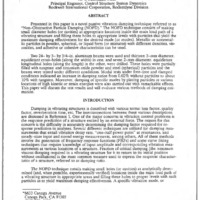Non-Obstructive Particle Damping Tests On Aluminum Beams
Item
-
Title
-
Non-Obstructive Particle Damping Tests On Aluminum Beams
-
Report Number
-
WL-TR-91-3078 Volume III, p. ICD-1 thru ICD-7
-
Creator
-
Panossian, H. V.
-
Corporate Author
-
Rockwell International Corporation, Rocketdyne Division
-
Date
-
1991
-
Date Issued
-
1991-08
-
Extent
-
7
-
Identifier
-
ADA241313
-
Format
-
1 online resource
-
Abstract
-
Presented in this paper is a novel passive vibration damping technique referred to as
"Non-Obstructive Particle DamJ?ing (NOPD).'' The NOPD technique consists of making
small diameter holes ( or cavities) at appropriate locations inside the main load path of a
vibrating structure and filling these holes to appropriate levels 'vvith particles that yield the
maximum damping effectiveness for the desired mode ( or modes). Metallic or nonmetallic
particles in powder, spherical, or liquid form ( or mixtures) with different densities. viscosities.
and adhesive or cohesive characteristics can be used.
Two 24- by 3- by 3/4-in. aluminum beams were used and thirteen 2-mm diameter.
equidistant cross-holes (along the width) in one. and seven 2-mm diameter. equidistant
longitudinal holes (along the length) in the other. were drilled. These holes were partially
filled with tungsten and zirconium oxide powder and steel (spherical) particles and the
beams were tested under different conditions. Modal tests under free-free and clamped
conditions indicated an increase in damping ratios from 0.02% without particles to about
10% with tungsten. Moreover, damping of specific modes by placing particles at various
locations of high kinetic or strain enemies were also carried out with remarkable effects.
This paper will discuss the test results and will evaluate various methods of damping estimation.
-
Description
-
Presented in this paper is a novel passive vibration damping technique referred to as
"Non-Obstructive Particle DamJ?ing (NOPD).'' The NOPD technique consists of making
small diameter holes ( or cavities) at appropriate locations inside the main load path of a
vibrating structure and filling these holes to appropriate levels 'vvith particles that yield the
maximum damping effectiveness for the desired mode ( or modes). Metallic or nonmetallic
particles in powder, spherical, or liquid form ( or mixtures) with different densities. viscosities.
and adhesive or cohesive characteristics can be used.
Two 24- by 3- by 3/4-in. aluminum beams were used and thirteen 2-mm diameter.
equidistant cross-holes (along the width) in one. and seven 2-mm diameter. equidistant
longitudinal holes (along the length) in the other. were drilled. These holes were partially
filled with tungsten and zirconium oxide powder and steel (spherical) particles and the
beams were tested under different conditions. Modal tests under free-free and clamped
conditions indicated an increase in damping ratios from 0.02% without particles to about
10% with tungsten. Moreover, damping of specific modes by placing particles at various
locations of high kinetic or strain enemies were also carried out with remarkable effects.
This paper will discuss the test results and will evaluate various methods of damping estimation.
-
Distribution Classification
-
1
-
Distribution Conflict
-
No
-
DTIC Record Exists
-
No
-
Illinois Tech Related
-
No
-
Photo Quality
-
Not Needed
-
Report Availability
-
Full text available
 articleICD
articleICD